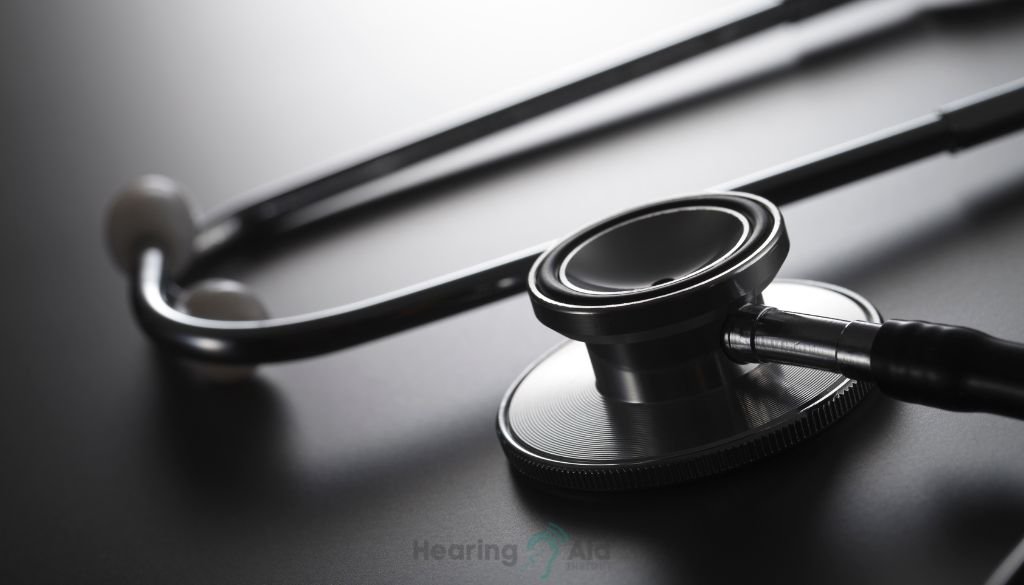Can You Use a Stethoscope with Hearing Aids? It is pertinent for medical professionals and individuals with hearing loss who rely on both devices. The need to use a stethoscope is essential in healthcare settings, yet many believe that hearing aids are incompatible with them. This article aims to dispel this misconception and provide practical solutions for integrating hearing aids with stethoscopes effectively.

Factors such as the type of hearing aid, the level of hearing loss, and the design of the stethoscope play a crucial role in determining the best approach. We will investigate various options and technologies available that allow individuals with hearing aids to use stethoscopes without hindrance. These solutions ensure that those in the healthcare profession can continue to perform their duties efficiently while managing hearing loss. We aim to offer insights and guidance to enable the seamless use of stethoscopes for those wearing hearing aids, ensuring they can confidently and effectively fulfil their roles in healthcare settings.
Key Takeaways:
- Individuals with hearing aids can use stethoscopes with the right tools and techniques.
- The type of hearing aid, degree of hearing loss, and stethoscope design play a role in finding a suitable solution.
- Amplified stethoscopes, visual cues, and connectivity options with Bluetooth-enabled hearing aids can enhance stethoscope use.
- Consulting with an audiologist can provide personalized guidance for using stethoscopes with hearing aids.
- By utilizing resources and technologies, healthcare professionals with hearing loss can provide outstanding care while staying connected to the medical world.
Understanding Different Types of Hearing Loss and Degrees of Severity
Hearing loss is a complex condition that can vary in type and severity, affecting individuals differently. Understanding the different types and degrees of hearing loss is essential to determine the appropriate solutions and interventions. Let’s explore the various categories of hearing loss and their corresponding levels of severity.
Types of Hearing Loss
“Conductive hearing loss: This type of hearing loss occurs when there is a problem in the outer or middle ear that prevents sound from reaching the inner ear. Common causes include ear infections, fluid buildup, or blockages. Sensorineural hearing loss: This is the most common type of hearing loss and is caused by damage to the inner ear or the auditory nerve. Aging, exposure to loud noises, certain medications, and genetic factors can contribute to sensorineural hearing loss. Mixed hearing loss: This is a combination of conductive and sensorineural hearing loss, often involving damage to both the outer/middle ear and the inner ear.”
Mild hearing loss: Mild hearing loss refers to the ability to hear sounds above 26-40 dB. Individuals with mild hearing loss may struggle to hear soft or distant sounds and may benefit from hearing aids in certain situations.
Moderate hearing loss: Moderate hearing loss ranges from 40-69 dB and can significantly impact an individual’s ability to understand speech, especially in noisy environments. Hearing aids may be recommended for individuals with moderate hearing loss to improve communication and overall quality of life.
Severe and profound hearing loss: Severe hearing loss is the ability to hear sounds above 70-94 dB, while profound hearing loss means a person cannot listen to sounds lower than 95 dB. Individuals with severe to profound hearing loss may rely on hearing aids or cochlear implants to access sound and communicate effectively.
Understanding the type and degree of hearing loss is crucial in determining the most appropriate interventions, including hearing aids. Consultation with an audiologist can provide personalized guidance and ensure individuals receive the best solutions for their hearing needs.
Exploring Options for Using Stethoscopes with Different Types of Hearing Aids
The type of hearing aid used plays a significant role in determining the best stethoscope approach. Different types of hearing aids, such as Completely in the Canal (CIC), In the Ear (ITE), Behind the Ear (BTE), and Cochlear Implants (CI), have varying considerations when it comes to stethoscope compatibility.
For individuals with CIC and ITE hearing aids, placing the stethoscope directly in the ear against the hearing aid can be uncomfortable. Many users find it easier to remove their hearing aids temporarily and use amplified stethoscopes instead. On the other hand, BTE hearing aids offer more options for interfacing with stethoscopes. One option is using a silhouette or a direct audio input cable to connect the hearing aid to the stethoscope. Cochlear implants, on the other hand, can be connected to amplified stethoscopes through direct audio input or induction signals.
When exploring options for using stethoscopes with different types of hearing aids, it’s crucial to consider the specific requirements and features of each hearing aid type. This ensures that individuals with hearing loss can find the most suitable solution for effectively using stethoscopes in their healthcare practice.
Amplified Stethoscopes for Individuals with Hearing Loss
Amplified stethoscopes are a valuable tool for individuals with hearing loss, providing enhanced sound amplification and active noise cancellation. These stethoscopes offer up to 40 times amplification, allowing clinicians to hear even the faintest sounds in challenging environments. For individuals with mild hearing loss who do not use hearing aids, amplified stethoscopes can be a standalone solution to improve their auscultation abilities.
Furthermore, individuals with hearing aids may also benefit from using amplified stethoscopes alongside their devices. The Eko CORE Digital Attachment and the Eko DUO ECG + Digital Stethoscope are excellent options for individuals with hearing loss. These devices provide amplified sound and offer additional features through the Eko App. Clinicians can visualize heart sound waveforms in real-time, enhancing their diagnostic capabilities.
In addition, some amplified stethoscopes can connect to Bluetooth-enabled hearing aids, allowing for wireless streaming of sounds. This feature provides convenience and flexibility, enabling clinicians to use their stethoscopes without the hassle of additional cables or attachments. With the ability to connect hearing aids to Bluetooth on iPhone, clinicians can seamlessly integrate amplified stethoscopes into their practice.
Benefits of Amplified Stethoscopes:
- Up to 40 times amplification for enhanced sound perception
- Active noise cancellation to reduce background noise
- Real-time visualization of heart sound waveforms for improved diagnostics
- Wireless connectivity to Bluetooth-enabled hearing aids
Amplified stethoscopes offer a practical solution for individuals with hearing loss, whether they use hearing aids or not. By utilizing these devices, clinicians can ensure accurate and precise auscultation, providing high-quality care to their patients.
Read also: can a head cold cause hearing loss?
Visualization and AI Analysis for Enhanced Stethoscope Use
Pairing a stethoscope with the Eko App can provide clinicians with visual cues and recordings to complement their auscultation. The Eko App allows users to visualize heart sound waveforms, which can help identify abnormalities. This visualization feature enhances the accuracy and precision of diagnosing cardiovascular conditions. Additionally, the app’s AI analysis can flag potential signs of heart disease, such as AFib, providing an extra layer of diagnostic support.
Clinicians can use the Eko App to enhance their stethoscope use by accessing real-time visualizations and AI-powered analysis. These tools can aid in the early detection and monitoring of heart conditions, improving patient outcomes. Combining traditional auscultation with visual cues and AI analysis offers a comprehensive approach to cardiovascular assessment.
Benefits of Visualization and AI Analysis:
- Improved accuracy and precision in diagnosing cardiovascular conditions
- Enhanced ability to detect abnormalities in heart sound waveforms
- Early detection and monitoring of heart disease
- Additional diagnostic support through AI-powered analysis
“The integration of visualizations and AI analysis with stethoscope use revolutionizes the way clinicians assess cardiovascular health. These advancements not only enhance diagnostic capabilities but also streamline the overall patient care process.”
While using amplified stethoscopes and visualization tools can enhance stethoscope use, certain precautions should still be taken to protect hearing aids and prevent infections. For example, hearing aids should be removed or protected during X-rays, and proper hygiene measures should be followed to avoid ear infections.
Consulting with Audiologists for Custom Solutions
When using stethoscopes with hearing aids, consulting with an audiologist is essential for finding custom solutions that cater to individual needs. Audiologists assess hearing loss and can provide personalized guidance based on specific hearing aid models and features.
By seeking guidance from an audiologist, individuals can address concerns or issues, such as hearing aid whistling, to ensure optimal performance and comfort. Audiologists can recommend custom hearing aids or earpieces tailored to fit and work seamlessly with stethoscopes.
Furthermore, audiologists stay abreast of the latest advancements in hearing aid technology and can offer recommendations for the most suitable options. They can help individuals determine if they need hearing aids based on their hearing evaluation and guide them through selecting the right hearing aid type and features.
Working with an audiologist provides several benefits:
- Personalized solutions: Audiologists can assess individual hearing needs and provide custom solutions, ensuring that the most appropriate and effective options are explored.
- Expert guidance: Audiologists are highly trained professionals who specialize in hearing health and can offer specialist advice on using stethoscopes with hearing aids.
- Ongoing support: Audiologists can provide ongoing support and follow-up care, helping individuals adapt to using stethoscopes with their hearing aids and addressing any challenges that may arise.
In conclusion, consulting with an audiologist is crucial for individuals with hearing aids who wish to use stethoscopes. Audiologists can offer personalized solutions, expert guidance, and ongoing support to ensure that individuals can effectively utilize stethoscopes while wearing their hearing aids, enhancing their ability to provide outstanding care and stay connected to the medical world.
Conclusion
In conclusion, individuals with hearing aids can use stethoscopes with the right tools and techniques. The type of hearing aid, degree of hearing loss, and stethoscope design all play a role in finding the most suitable solution.
Amplified stethoscopes, visual cues, and connectivity options with Bluetooth-enabled hearing aids are available to enhance stethoscope use for individuals with hearing loss. These tools provide amplification and noise cancellation features to ensure clear and precise auscultation.
Working with an audiologist can provide personalized guidance and ensure that the best solutions are found. Audiologists can assess hearing needs, recommend custom solutions, and offer support.
By utilizing these resources and technologies, healthcare professionals with hearing loss can continue to provide outstanding care while staying connected to the medical world. With the right tools, individuals can confidently use stethoscopes and perform their duties effectively, ensuring the highest level of patient care.
Does tinnitus from Viagra go away? Unravel the complexities in our detailed guide, exploring the side effects of this medication and their impact on hearing.
Frequently Asked Questions
Can I use a stethoscope with my hearing aids?
Yes, it is possible to use a stethoscope while wearing hearing aids. Solutions are available to enable individuals with hearing aids to use stethoscopes effectively.
What type of hearing loss requires a hearing aid?
The type and severity of hearing loss can vary, but individuals with mild to profound hearing loss may typically require hearing aids.
How can I use a stethoscope with different types of hearing aids?
The approach to using a stethoscope depends on the type of hearing aid. Completely in the Canal (CIC), In the Ear (ITE), Behind the Ear (BTE), and Cochlear Implants (CI) all require different considerations when using stethoscopes.
Are there amplified stethoscopes available for individuals with hearing loss?
Yes, amplified stethoscopes can provide up to 40x amplification and active noise cancellation to help individuals with hearing loss hear sounds loud and clear.
Can I connect my amplified stethoscope to my Bluetooth-enabled hearing aids?
Yes, some amplified stethoscopes can connect to Bluetooth-enabled hearing aids for wireless streaming of sounds.
How can visualization and AI analysis enhance stethoscope use?
Pairing a stethoscope with the Eko App allows clinicians to visualize heart sound waveforms in real time and provides AI analysis to help identify potential abnormalities.
Should I consult with an audiologist about using stethoscopes with hearing aids?
It is recommended to consult an audiologist for personalized guidance on finding the most suitable solutions for using stethoscopes with hearing aids.



